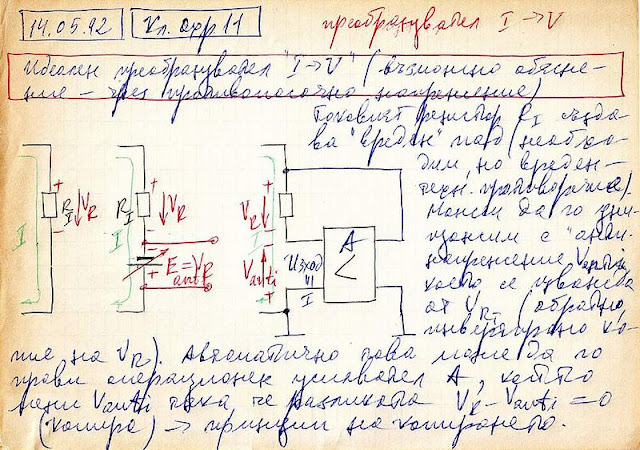Where has this current gone in my current-voltage converter?
This is my answer to SE EE question Where has this current gone in my current-voltage converter?
My answer
The necessary philosophy
I read these answers full of technical details and wonder how it is possible not to reveal the simple but brilliant idea behind this op-amp circuit consisting only of a resistor and op-amp? I realized it 30 years ago (Fig. 1) and with its help I was able to understand and explain many other op-amp circuits.
 |
Fig. 1. A conceptual picture of an active current-to-voltage converter from my archive (1992). Here is the translated text: |
Basic idea
The idea is obvious: To measure the current I by a voltmeter, we break the circuit, insert a resistor RI and measure the voltage drop across it (VR = I.RI). But this voltage introduces an error since it is subtracted from the input "current-creating" voltage VIN and the current decreases. So we decide to destroy it by adding an equivalent voltage V = VR. For this purpose, we break again the circuit and insert a varying voltage source producing the compensating voltage V. This voltage is added to the input voltage and the error is eliminated - Fig. 2.
 |
Fig. 2. Full conceptual circuit of four elements in a loop (the picture is taken from a similar story about the inverting amplifier). Note the two voltages are summed in a series manner. |
Fig. 3. Op-amp implementation of the idea
To close the current path, we have to draw the respective power source - negative if the input voltage is positive (like in Fig. 3) and positive if the input voltage is negative.
How does the op-amp do it?
It is interesting to see how the op-amp copies the voltage drop VR at its output. According to KVL, we can see in Fig. 2 and Fig. 3 a loop of three voltages - VR, VOUT and VA. The op-amp changes VOUT so that to keep VA zero (negative feedback). As a result, VOUT = VR.
Another clever trick is that we use the compensating voltage as a buffered, grounded and inverted output voltage (the last feature is a "gift" that is not always desired).
Visualized operation
To illustrate the circuit operation in a more attractive way, we can "geometrically" draw the circuit diagram - Fig. 4.
 |
Fig. 5. The transimpedance amplifier presented as a "piece of wire" |
Passive vs active version
As a rule, we know the passive is bad and the active is good. But here the passive "circuit" (resistor) has a very significant advantage over the active - it allows to measure currents of large magnitude.
The problem with the active op-amp current-to-voltage converter is that the current passes through its output stage... and the latter must withstand it. That is why the ammeters inside multimeters are not made with the op-amp circuit, no matter how perfect it is, but with the simple passive circuit (a humble resistor between the inputs).


Comments
Post a Comment